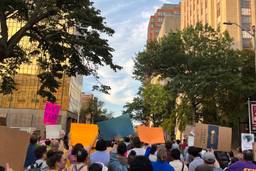These Activists Are Trying To Solve the Housing Crisis—By Suing the Suburbs
Bay Area activists take a suburb to court, saying it refused to allow high-density housing
s.e. smith

Diego Aguilar, 23, lives in Berkeley, Calif., and works at a technology company in Emeryville. Forty-six percent of his $2,400 monthly income goes to rent, which is fairly typical for Berkeley.
His plight is a common one. The Bay Area housing market has been in a panicked crunch. In San Francisco, the median monthly rent hit a record high of $3,530 in September, with a vacancy rate below 4 percent — not enough to accommodate the 32,000 new residents who have flooded into the city over the last five years. Many of those residents are arriving to take high-paid tech jobs in Silicon Valley; San Francisco and San Mateo counties have one of the lowest unemployment rates in the nation, at 3.5 percent in August 2015.
Between 2010 and 2015, San Francisco’s eviction rate surged by more than 50 percent, driving poorer residents out of areas like the Mission District to make room for new condos and expensive apartments. Last year, 2,800 people applied for just 60 units of affordable housing in one new development.
The group Sue the Suburbs is using a novel legal strategy to try to get the suburbs to pick up some of the housing burden. As a test case, the group plans to take the East Bay city of Lafayette to court, demanding that the wealthy and low-density city — which has nearly twice San Francisco’s median household income of $75,000 and less than one-tenth its residents per square mile — approve a 315-unit housing project. If the suit succeeds, the case could create a precedent for relieving housing pressure in the Bay — and potentially other regions of the country. Promoting high-density construction would deter urban sprawl and open up rentals for commuters.
Lafayette was incorporated in 1968 specifically so the city could take planning authority away from Contra Costa County and remain rural and sparsely populated. When developer O’Brien Homes approached the city in 2011 with the proposal for the 315-unit project, it was met with opposition from both residents and city planners, who said the project would not be “compatible with the residential neighborhoods in the vicinity.” In response, the city and the developer negotiated a plan to build 44 single-family homes instead.
Sue the Suburbs contests that the city council made clear to the developer that approval was contingent on submitting a lower-density plan— which would put the city on shaky legal ground. The California Housing Accountability Act of 1982 says a city cannot make a housing development conditional on a reduction in density unless the development would cause unavoidable harm to public health or safety. In theory, then, if the city deprived potential residents of housing, California legal code allows any citizen to sue to enforce the law. Sue the Suburbs is gathering plaintiffs to test that theory. Diego Aguilar is among the 21 people who had promised to join the suit as of September.
Sonja Trauss, a long-time housing activist, is the bubbly and insistent force behind Sue the Suburbs. A frequent figure at planning commission meetings on both sides of the Bay, Trauss differs from many local housing advocates in seeing developers as potential allies. She argues that encouraging development will push rents down for all by making more units available, which benefits both housing advocates — who want more units on the market — and developers, who want to make a profit. Therefore, she plans to turn to big developers, which she calls “captains of industry,” for financial and logistical support for her campaign. She’ll also reach out to the tech industry, since it has a vested interest in housing its workers.
Tech workers were the likely targets of the 315-unit project in Lafayette, which offered housing for “moderate income residents” — those who make 120 percent of the city’s median wage. Critics, however, say that it would do little for low-income people. More broadly, many believe that market-based approaches will not address affordability.
Scott Weaver, a spokesperson for the San Francisco Tenant’s Union, notes that despite the construction of market rate housing — 3,500 new units in San Francisco last year, the highest annual rate in two decades — rents are still rising. “Supply-side economics has done … nothing but exacerbate economic inequality,” he says, adding that large developers often manage to wiggle out of even the limited requirement to set aside 12 percent of new units as affordable.
Nevertheless, Trauss’s plan is gathering support as one piece of the push for availability and affordability. Another potential plaintiff, Rafael Solari, is a housing activist who has worked with Trauss on other projects. A native of the Bay Area, Solari has watched rents climb and fears being priced out of his small studio in San Francisco’s Western SoMa, which costs approximately 34 percent of his income — a strain in an expensive city. “It’s hard to imagine staying here long-term because of the housing problems,” he says.
Steven Falk, Lafayette’s city manager, says Sue the Suburbs has picked “the wrong city” for its test case, noting that Lafayette recently approved construction of 400 multi-family housing units around the city, 15 percent of which will be earmarked as affordable housing. It has also committed (over residents’ objections) to building denser housing around transit stations to ameliorate the regional shortages.
Sue the Suburbs has until December 13 to file an administrative writ asking a judge to agree Lafayette is violating the law.
Because of the novel questions the case is litigating, Trauss says, it could end up setting case law that would forever change the way California’s Housing Accountability Act is enforced.
A victory could impact other locales, too. Though California law doesn’t apply elsewhere, case law supporting mandates for dense development would be a powerful precedent for affordable housing advocates. Seattle, New York and Boston, for example, are all experiencing upswings in their populations that are putting pressure on their housing markets. The median one-bedroom rents in those cities have risen to $1,650, $3,160 and $2,270, respectively. All three regions have affluent suburbs that are recalcitrant about building housing. Other attorneys could draw upon a favorable ruling in California to support their own cases for dense development — leading to a domino effect of lawsuits with the potential to change the housing landscape. Should that happen, Trauss’s market-based theories will be put to the test.








